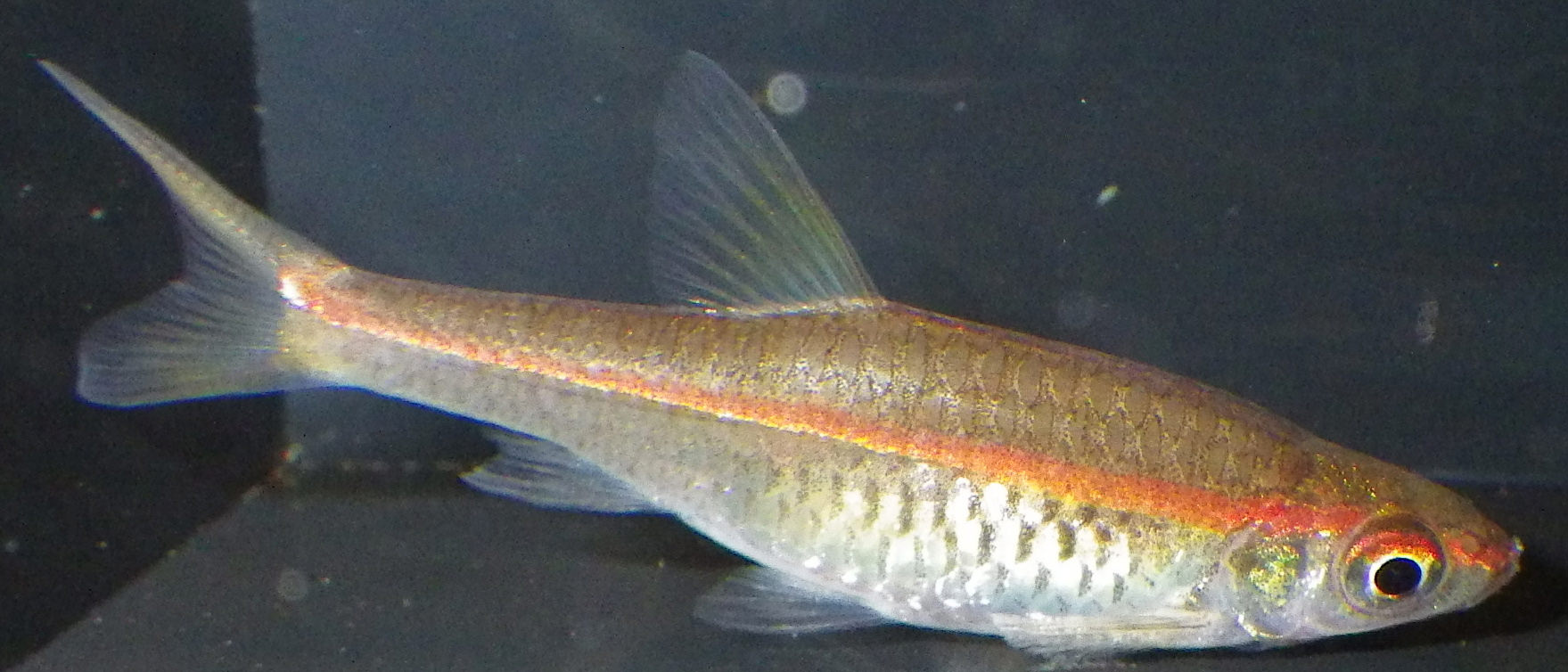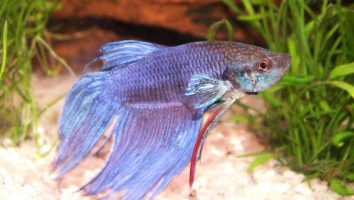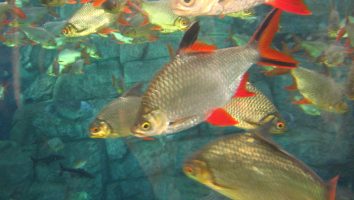The Red-striped Rasbora is a beautiful freshwater fish that is perfect for beginner aquarists. They’re easy to care for, and make a great addition to any tank!
In this guide, we’ll teach you everything you need to know about Red-striped Rasbora care. You’ll learn about their diet, tank mates, size, and more!
Table of contents
Species overview
The Red-Striped Rasbora (Trigonostigma espei) is a small and colorful freshwater fish that is native to Thailand, Malaysia, and Singapore.
They prefer clear water with a lot of plants and hiding places. This is something that is not too difficult to replicate in the home aquarium.
The diet of the Red-Striped Rasbora is mostly composed of small insects and crustaceans. In the wild, they will also eat smaller fish, so it is best to avoid keeping them with tank mates that are much larger than they are.
The main attraction of the Red-Striped Rasbora is their beautiful coloration. They are mostly orange with red stripes running down their sides. This makes them a very popular choice for freshwater aquariums.
Appearance

The Red-striped rasbora is a small freshwater fish that is easily identified by the two red stripes that run horizontally down its body.
The first stripe is located on the fish’s head just behind the eyes and extends to the base of the tail. The second stripe starts at the base of the pectoral fins and also extends to the base of the tail.
These stripes are quite thin and can be difficult to see in low light conditions. The background color of the fish is a silver/gray color with a slight greenish tint.
The fins on this fish are all relatively small and unremarkable. The dorsal fin is located midway down the fish’s body and is the same size as the anal fin. The caudal fin is forked and slightly taller than the dorsal and anal fins.
The pectoral fins are located just behind the head and are slightly shorter than the dorsal and anal fins. The ventral fins are located just behind the pectoral fins and are very small.
Lifespan
The maximum lifespan of a red-striped rasbora in the wild is unknown. In captivity, however, they often live for 3 to 5 years.
There are a number of things that impact how long red-striped rasboras live. These include things like water quality, diet, and stress.
If you provide them with good care, they’ll likely live on the higher end of this range.
Size
The maximum size of the Red-striped rasbora is about 2 inches.
Tank
Tank Size
The recommended minimum tank size for a school of red-striped rasboras is 10 gallons. If you’re looking for a small freshwater fish that can fit in an average-sized tank, this is a good option.
We personally recommend a slightly larger tank if you can accommodate it. Every extra space will make a big difference and allow you to keep a larger school or more tank mates if you’re interested in a community tank.
Water Parameters
Rasboras are a schooling fish, so you should plan on keeping at least six of them in your aquarium. They do best in a planted tank with plenty of open space to swim.
Rasboras prefer slightly acidic water with a temperature between 72 and 82 degrees Fahrenheit. The water should also be soft to medium-hard.
As with most fish, you should do a partial water change at least once a week to keep the tank clean and the water fresh.
- Water temperature: 72-82 degrees Fahrenheit
- pH levels: 6.0-7.5
- Water hardness: Soft to medium-hard
- Alkalinity Levels: 4-8 dKH
What To Put In Their Tank
When it comes to the substrate in a Red-striped Rasbora tank, you have a few different options. The most popular is to use sand since it’s soft and these fish like to dig around a bit.
Other people prefer to go with a gravel substrate since it’s a little easier to clean. It’s really up to you and what you’re comfortable with.
As for plants, you can choose to include them or not. These fish aren’t known to eat plants, but they might uproot them while digging around. If you do want to include plants we recommend something that can withstand a little abuse (like Hornwort or Java Fern).
When it comes to decorations, these fish love hiding places. Driftwood, caves, and rocks are all great choices. Just make sure that whatever you use is securely in place. These fish are known to jump out of the water from time to time and you don’t want anything falling on them!
Common Diseases
The good news with Red-striped rasboras is that they are a pretty hardy fish. They don’t get sick too easily and can withstand a fair amount of abuse.
However, that doesn’t mean that they don’t ever get sick. Any fish kept in subpar conditions is at risk of disease, and the Red-striped rasbora is no exception.
The most common disease that these fish experience is ich. This is a pretty nasty parasite that can quickly kill your fish if it’s not dealt with.
Fortunately, ich is relatively easy to treat and most fish will make a full recovery if they are treated promptly.
The best way to prevent your fish from getting sick is to maintain clean and stable water conditions. This will help to keep your fish healthy and reduce the risk of disease.
Behavior & Temperament
The red-striped rasbora is a schooling fish, which means it does best when it’s in a group. In the wild, these fish live in large schools of hundreds or even thousands of fish. So, if you’re keeping them in captivity, it’s important to try and replicate that environment as best as you can.
Ideally, you should have at least six of these fish in your tank. But, the more the merrier! When they’re in a group, they’re much more active and tend to swim around a lot more. They’re also less likely to be stressed, which is good for their overall health.
These fish are very peaceful and get along well with other tank mates. They’re not aggressive at all and will mostly just stick to themselves. The only time you might see them being territorial is if you have two males in the same tank. In that case, they might fight over who gets to be the alpha.
Tank Mates
The best tank mates for Red-striped rasboras are other small and peaceful fish. These fish are timid by nature and can easily get overwhelmed by larger or more aggressive tank mates.
They’re also schooling fish, so it’s best to keep them in groups of at least six. This will help reduce their stress levels and make them feel more comfortable in their environment.
Some good tank mates for Red-striped rasboras include:
- Neon Tetras
- Cardinal Tetras
- Whitecloud Mountain Minnows
- Ember Tetras
- Ghost Shrimp
- Cherry Shrimp
Breeding
Red-striped rasboras are easy to breed in captivity. They don’t have a lot of specific requirements, and they will usually spawn without any help from the keeper.
The first step is to set up a breeding tank. It should be at least 20 gallons in size and filled with soft, acidic water. You can use a sponge filter to avoid disturbing the fry.
Then, add some live plants and moss. These will give the fry a place to hide and feel safe. Be sure to add an air stone to keep the water oxygenated.
When everything is set up, add two or three males for every female. Rasboras are schooling fish, so they will feel more comfortable in a group.
Feed the fish well and wait for them to spawn. The female will lay her eggs on the plants, and the male will fertilize them.
The eggs will hatch in about 24 hours. When they do, remove the adults from the tank. They will eat the fry if given the chance.
The fry will be tiny, so you will need to feed them live foods. Baby brine shrimp and micro worms are good options. As they grow, you can start to add crushed flake food to their diet.
Conclusion
The Red-Striped Rasbora is a beautiful and peaceful fish that is perfect for the beginner aquarist. They’re easy to care for and get along well with other community fish.
We highly recommend this fish to anyone who is looking for a low-maintenance and rewarding pet.












